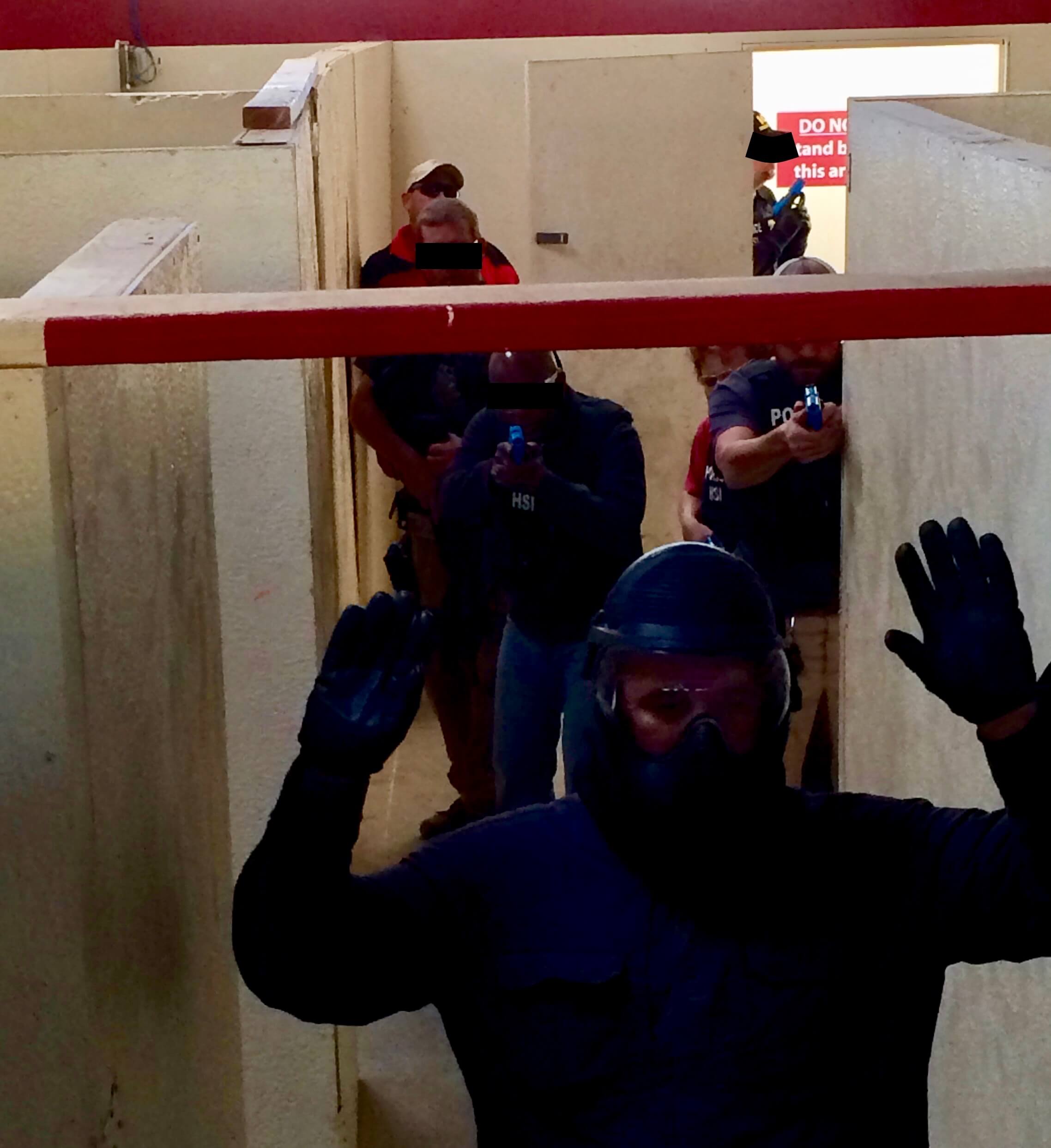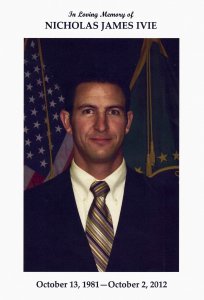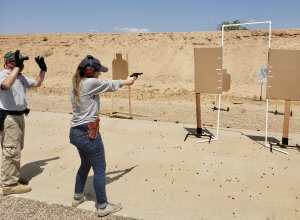The Under-Practiced Art of Issuing a Challenge

Many new gun owners are never trained how to issue a challenge, or even given that option by their instructors. Some may not even know what “issuing a challenge” means.
When I was a young man (many, many moons ago), a frequently quoted pearl of old men’s traditional wisdom was “Don’t pull that pistol unless you intend to use it.”

Indeed, in the USAF Security Police of the 1980s, I was trained to yell “Halt!” with my palm on the wooden handle of my revolver, still safely wrapped in its Bill Jordan holster.
Although poorly worded, those senior NCOs really meant “Don’t brandish your pistol (waive it about) unnecessarily,” and “If you’re even going to carry that thing, you’d better be mentally prepared to deal with the consequences of using it, should you have to.”
Neither of which has ever been bad advice.
But it has led to some possibly dangerous misperceptions among the shooting public. I actually had a student tell me, “I know that if I pull it out, I’m going to use it on somebody.”
Hopefully, not just anybody.
I’m guessing they meant that they were mentally prepared to use it. But it sounded as if they didn’t feel they could pull it out unless and until they were planning to shoot a person.
Something like 16 out of 17 times, when an armed citizen points a gun at somebody and tells them to rob or rape somebody else, the bad guy goes away. No blood on the pavement (or the carpet). No lawyer fees. No endless litigation.
If that’s the most common civilian use of a firearm, why don’t we practice it? If you don’t practice verbalization in conjunction with your other firearms handling and marksmanship skills, it will NOT happen on the street. Or worse, you will say something that you wish you hadn’t said later.
What a Challenge is
“Challenge” is perhaps a stupid name for it, as that word implies throwing down the gauntlet, double-dog daring somebody to do something. Instead, in the personal protection context, a challenge is a warning.
When NOT to Issue a Challenge
Arizona law (ARS Title 13 Chapter 4, which you should read if you are armed in Arizona) does not, to the best of my knowledge, require anyone to give a warning before using deadly force.
In a Flash Fight, you may not have time to say anything. If you are in the open it may be tactically inadvisable, because it puts the ball in the other guy’s court.
Case studies of warnings gone bad
May I? Can I? Should I? Dan McKown’s story
Dan McKown, now a paraplegic comedian, had been lawfully carrying concealed in a shopping mall in Tacoma, Washington. When a scumbag with an AK came in and started shooting, McKown drew his pistol. He heard the shots and screams around the corner but did not see the killer walk in, or actually witness him shooting anybody. Concerned responding police might mistake him for the shooter, McKown re-holstered.
At that moment, the killer rounded the corner. I assume McKown had some sort of shoulder holster or cross-draw rig, because he described himself as standing there with his hand in his jacket like Napoleon Bonaparte.
Our intrepid armed citizen had never, to my knowledge, done any role-playing Use of Force training. He wasn’t sure he was allowed to shoot a guy who wasn’t actively murdering people, even if the guy just had. Further, McKown (who still had the use of his feet at the time) had never been trained to deal with line of fire issues, and was concerned that if he shot, he might hit customers on the opposite side of the mall.

I seriously doubt McKown had ever trained to issue a challenge from a covered (or at least concealed) position with his gun out, pointed at the bad guy.
Instead, he left his gun in its holster, out of sight, and said, “Young man, I think you need to put your weapon down.”
That’s how Dan McKown ended up in a wheelchair.
The bad guy’s first shot went through McKown’s spine. At that point, there was no more doubt in McKown’s mind what he needed to do, but it was too late. The bad guy shot him over and over.
I’m not knocking Dan. His heart was in the right place. But like many, perhaps even most, gun owners, he found out too late that the mere presence of a firearm, without relevant, practical, realistic training, will not ward off evil spirits like some magic talisman.
“To each there comes in their lifetime a special moment when they are figuratively tapped on the shoulder and offered a chance to do a very special thing, unique to them and fitted to their talents. What a tragedy if that moment finds them unprepared or unqualified for that which could have been their finest hour.”
–Sir Winston Churchill
Texas DV
My law enforcement agency had a policy that all firearms instructors had to get training from outside our organization annually. That was to avoid something called “training incest:” failure to import new ideas or learn different things.
One of the organizations who trained us was comprised primarily of FBI HRT (SWAT) operators. The lead instructor had been a street cop in Texas. He told us of an incident where a Texas officer had responded to a domestic violence call.
A woman had locked herself in a bedroom with their baby. The angry husband or boyfriend was in the hallway with a revolver. The cop took up a position around the corner, pointed his service pistol at the angry man, and issued a challenge (probably “Drop the gun!”).
The man looked at the cop for a moment.
Then he shot the woman through the door, killing her.
Then the cop shot the killer. A second too late.
If you are a knight errant, and you come across a dragon about to have lunch, ambush him before he has a chance to hurt the maiden. You owe him no courtesies.
When you SHOULD Issue a Challenge
Case studies of when a warning might have averted Blue on Blue
STEM School Highlands Ranch, Colorado

If you are a responsibly armed citizen or off-duty cop at an active shooter event, maybe others are too.
School security guard Shamson Sundara heard shots from two different directions at STEM School Highlands Ranch, and recognized that it was a coordinated (more than one bad guy) attack. After he disarmed one of the wannabe killers and held him at gunpoint, he saw the muzzle of a rifle, held by a man in civilian clothes, coming around the corner.
Sundara opened fire, missing the man with the rifle, who turned out to be a plainclothes deputy responding to the shooting. Rather than returning fire (I’m guessing Sundara was in a school security uniform), the cops challenged him. He complied, and no further shots ensued. Unfortunately, Sundara’s shots went through a wall, injuring one or two students (depending on whose version you read).
 BPA Nick Ivie
BPA Nick Ivie
On 02 Oct 2012, US Border Patrol Agent Nick Ivie was shot and killed by his fellow agents in the dark. “Don’t move!” might’ve prompted a “Hey, it’s me!” response from a comrade.
I was actually tackled in the dark once, while chasing a group that had bailed out of a Ford Escape (for some reason, that brand name was popular with smugglers; unlike the Chevy Nova, which sounds a lot like no va).
If I’d been yelling “Policia! Parense todos!” I might not have been mistaken for the last member of the fleeing group, when I was, in fact, the closest of the pursuing agents TO the group.
Stonewall Jackson
Confederate General Thomas J. “Stonewall” Jackson was shot by his own troops while returning from a leader’s recon on the night of 02 May 1863, in the brushy thickets of a dense second-growth forest, during the Civil War Battle of Chancellorsville. A better performed challenge on the part of the sentry, or a clearer response on the part of the general, might’ve prolonged America’s bloodiest conflict. Instead, Robert E. Lee lost the use of his most effective commander when the sentry (or sentries) shot Jackson.
Goals of Challenge training
When we do challenge drills, our objectives are twofold:
- To teach you how to conduct a challenge, and
- To give you some Use of Force decision making experience
How to issue a challenge
. . . is fairly simple. Ideally, you take some sort of cover first. It is not entirely unlike preparing to ambush someone. Almost always, your pistol is out. Depending on your level of suspicion and the presence of bystanders, you may or may not be pointing the gun at them (see To point, or not to point below).
If you are by walking to your car in a deserted parking garage late at night, and two miscreants approach you with cudgels and knives, that is the time to start shooting. It’s NOT the time for a challenge, unless perhaps you’ve already shot one, he’s down in his own blood, and the other is hesitating.
- If the accomplice runs away, get a good description and call the cops.
- If he keeps coming at you after you shoot his friend, that tells you something about his state of mind, and you should probably shoot him while you still have the chance.
- But if he hesitates, help him to make up his mind by telling him to “LEAVE, NOW!”
Then call the police before he calls them, because he will tell them lies about you. “This crazy b____ just pointed a gun at me for no reason!” Remember, unless and until thorough investigation proves otherwise,
the first to call 911 is the assumed victim.
Why tell him to leave, instead of holding him for the cops? Because cornered animals are more desperate than those who flee. Don’t worry–the world is full of security cameras, DNA evidence, cell phone records, etc. They’ll catch him, eventually.
What if, however, in the same deserted garage the same two guys approach you with likely, but not obvious, ill intent? Maybe you see no weapons, but the story they’re broadcasting doesn’t add up to what you observe. You MAY NOT shoot someone on mere suspicion.
This is the time to take cover behind an engine bloc, or at least put some sort of obstacle(s) between you, and try to ascertain their intent by establishing compliance.
How to Establish Compliance
Establishing compliance is determining if they are likely to cooperate, at least for now.
Compliance may be feigned; he might just pretend to comply long enough for you to lower your guard. Compliance can be revoked at any time. My friend Jim, who has decades of experience as a Corrections Officer, calls those people spinners: they start to go away but then turn and attack you suddenly.
Still, compliance is a place to start. A compliant person may turn on you, but a non-compliant person probably will.
You establish compliance by giving a command.
A challenge is not a plea, and not a negotiation. It is a dire warning.
K.I.S.S.
Like “Thou shalt not kill,” your challenge command should be short, succinct, to the point, and composed, at least mostly, of one syllable words.
- “STOP!” is good.
- “GO AWAY!” isn’t bad.
- “THAT’S CLOSE ENOUGH!” might get you roped into further conversation, but at least it might help you establish compliance.
- “GO ROB SOMONE ELSE!” gets the message across, and gives them an out (remember, as I mentioned above, cornered animals are more dangerous).
- “DROP THE KNIFE!” may be a useful litmus test.

Contrary to what you may have heard from some keyboard commando, you may NOT shoot somebody just becasue they are within 21 feet of you with a knife. It depends upon the totality of circumstances, such as inferred intent. We run numerous variations of the Tueller drill, and review relevant court cases, in our Lawful Use of Force classes.
Follow-on Commands
Non-movement implies compliance, so you should avoid commands that demand movement, like “SHOW ME YOUR HANDS!” He might do just that, by pulling a gun on you.
After you establish compliance, you can give additional commands, like “SLOWLY, lift up your shirt.” No, not like during Mardi Gras–it’s so you can see any weapons on their belt line.
Don’t scream
Don’t be shrill. You will probably be tense; that’s OK. You can use square breathing techniques (in over 4 seconds, hold for 4, out over 4) to control your nerves.
Be forceful, and loud enough to be heard through the viscous inner ear fluid of a drunk. But again, don’t scream. Try to sound serious, but almost bored. As Omar T, one of my journeymen (and a former Harlingen PD FTO) told me,
“Act like you’ve been there.”
Try not to curse too much. The cell phone cameras are rolling. We live in about the only country on earth where perceptions of how a criminal is apprehended are more important than the crimes he clearly committed.
Credibility is key
A challenge is not a bluff.
Avoid unrealistic ultimatums or count downs. Don’t tell a man who is not visibly armed “If you’re not gone in three seconds, I’m going to shoot you.” It might show you his gun in two seconds. If he hesitates for 4 seconds and you still may not lawfully shoot him, he’ll have called your bluff, and you’ll lose all credibility.
This is NOT about saving face. Credibility is vitally important. As with nuclear deterrence, his life and yours may depend upon it.
When you issue a challenge, you are assuming a leadership role. You are taking charge. In a tense, uncertain, high-consequence situation, the leader’s credibility is everything. Her word must be her bond. Like JK Rowling’s fictional cruciatus curse, a challenge doesn’t work unless you mean it.
To point, or not to point
Let’s say there’s a mob on your lawn who are judging you by the color of skin you were born with, through no fault of your own. Regardless of which angry mob is in your yard, or why they choose to hate you, if you have reason to believe they may burn your house to the ground with your family in it, by all means, issue a challenge.

But pointing at one person in a crowd–say, the guy with the unlit Molotov cocktail in one hand, and the Bic lighter in the other, who DOES constitute a deadly force threat–could be perceived as you threatening the whole crowd, not all of whom may be deadly force threats. Instigators in the crowd could use that perception to blame YOU for those conditions that were not of your making, whipping an unruly crowd into a murderous mob.
Best to tell the pyromaniac to set down the incendiary device from a Parking Lot ready (Guard hold) or perhaps even a Sul. If nothing else, there will be cameras showing the world how threatening you look, or don’t look (depending on your hold) from the crowd’s perspective. Don’t give spineless DAs an excuse to raid your house on trumped up assault charges.


Suggested Challenge Practice
You can practice challenges using the following outline:
- Bad guy role player “skulks” where he should not be
- Good guy trainee moves to cover, presents firearm, and gives challenge: “Don’t move!”
Variations for step 3 of this drill (try them all, in random order):
- Bad guy runs away–DIAL 911 AND REPORT
- Bad guy complies–tell him to leave–DIAL 911 AND REPORT
- Bad guy slowly gets closer, says “You don’t want to shoot me with that”–shoot him, DIAL 911 AND REPORT
Let’s be clear here: you may NOT blow somebody away just for acting suspicious or engaging in conversation. But ask yourself (as your defense attorney should ask the jury): what would any reasonable person do if somebody pointed a gun at them and told them to leave?
Even if their weapons are not yet visible, their non-compliance with your command tells you a lot about their state of mind and possible intent. What is the only plausible explanation for a hoodlum wanting to get closer to an armed citizen pointing a gun at them?
Of the 4 main types of weapons used in interpersonal confrontations (edged, impact, flexible, and projectile launching), three only work in proximity to the recipient. Your firearm has many disadvantages, but its main advantage is that it works over distance. If you let him get close enough, he negates that advantage. He can off-line or take away your projectile launcher, and if he does, we cannot count on him to use it responsibly or lawfully. According to the FBIs UCR (Uniform Crime Reporting) stats, fists, boots, hammers and knives kill far more people than rifles.
That’s one reason we spend so much time on off-lines, disarms, and weapon retention in our Defensive Pistol courses. We also work on challenges with structured role playing exercises in Lawful Use of Force classes.

The foundation of this article was excerpted from the Annotated Training Outline (after action report) we did for the 16 May 2021 Defensive Pistol Skill Builder class.
–George H, instructor, Heloderm LLC
